401210 Health Variations 3: Acute Exacerbations Report - Heart Failure
VerifiedAdded on 2022/10/06
|9
|2102
|16
Report
AI Summary
This report analyzes the case of Mrs. Brown, a 78-year-old female admitted to the emergency ward with acute exacerbation of chronic heart failure. The report details her symptoms, including dyspnea, hypertension, tachycardia, pulmonary edema, and atrial fibrillation, linking them to the underlying pathophysiology. It explores the nursing interventions implemented, such as oxygen therapy and monitoring of vital signs, including the use of defibrillators. The report also discusses the medications administered, including IV Furosemide and sublingual Glyceryl Trinitrate (GTN), explaining their roles in managing her condition. The analysis provides a comprehensive understanding of the patient's condition and the clinical strategies employed in her treatment. The report references various research papers to support the discussed concepts.
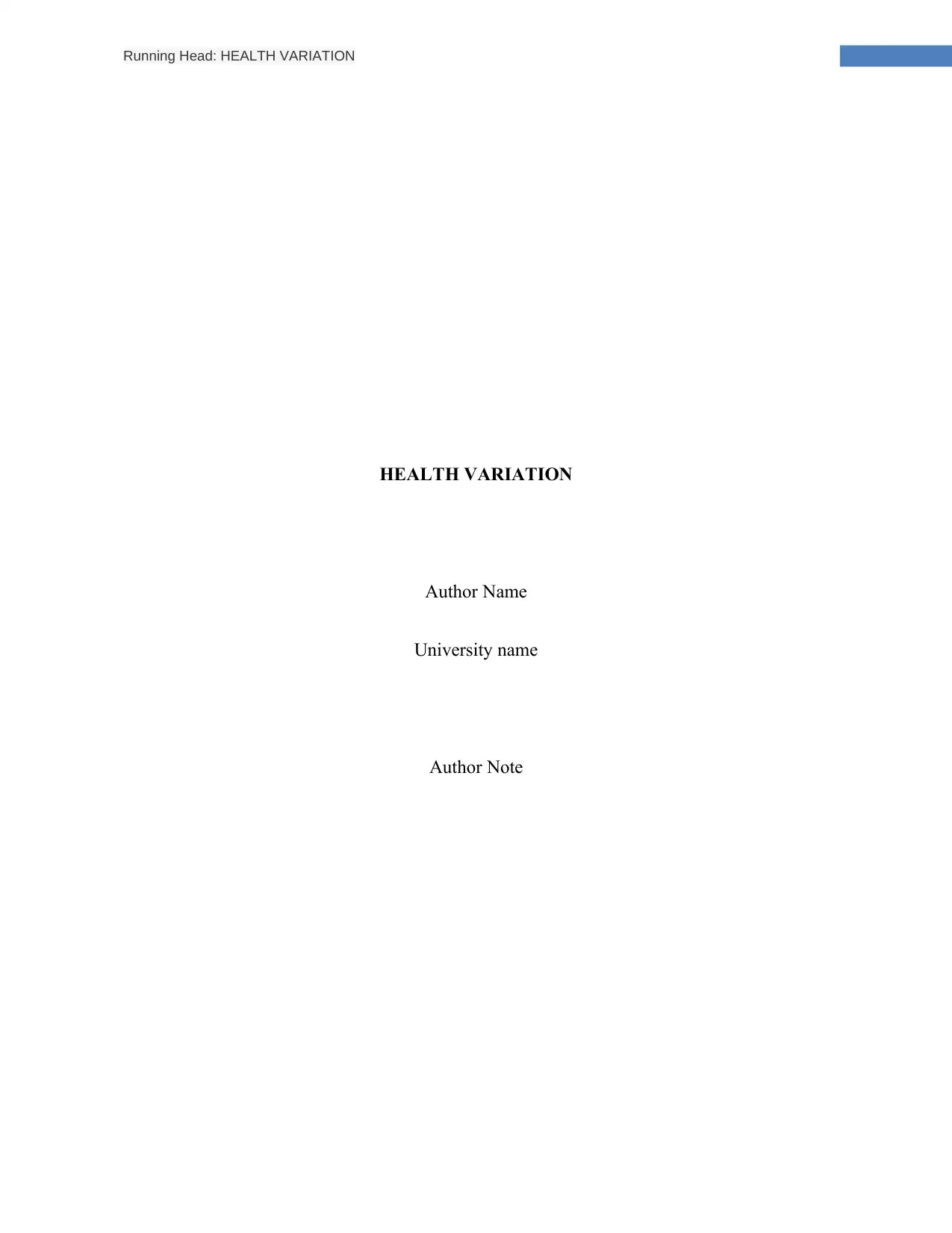
Running Head: HEALTH VARIATION
HEALTH VARIATION
Author Name
University name
Author Note
HEALTH VARIATION
Author Name
University name
Author Note
Paraphrase This Document
Need a fresh take? Get an instant paraphrase of this document with our AI Paraphraser
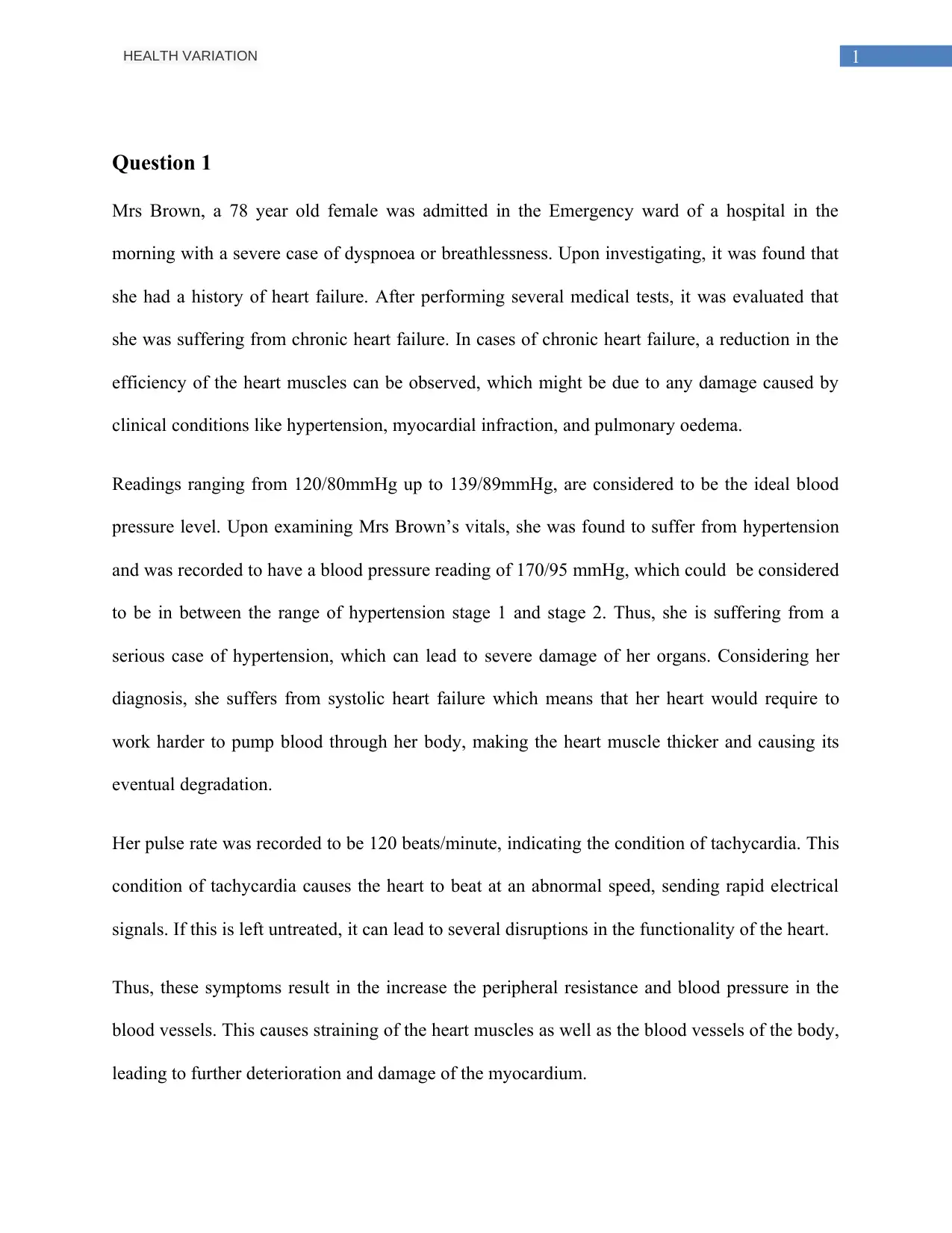
1HEALTH VARIATION
Question 1
Mrs Brown, a 78 year old female was admitted in the Emergency ward of a hospital in the
morning with a severe case of dyspnoea or breathlessness. Upon investigating, it was found that
she had a history of heart failure. After performing several medical tests, it was evaluated that
she was suffering from chronic heart failure. In cases of chronic heart failure, a reduction in the
efficiency of the heart muscles can be observed, which might be due to any damage caused by
clinical conditions like hypertension, myocardial infraction, and pulmonary oedema.
Readings ranging from 120/80mmHg up to 139/89mmHg, are considered to be the ideal blood
pressure level. Upon examining Mrs Brown’s vitals, she was found to suffer from hypertension
and was recorded to have a blood pressure reading of 170/95 mmHg, which could be considered
to be in between the range of hypertension stage 1 and stage 2. Thus, she is suffering from a
serious case of hypertension, which can lead to severe damage of her organs. Considering her
diagnosis, she suffers from systolic heart failure which means that her heart would require to
work harder to pump blood through her body, making the heart muscle thicker and causing its
eventual degradation.
Her pulse rate was recorded to be 120 beats/minute, indicating the condition of tachycardia. This
condition of tachycardia causes the heart to beat at an abnormal speed, sending rapid electrical
signals. If this is left untreated, it can lead to several disruptions in the functionality of the heart.
Thus, these symptoms result in the increase the peripheral resistance and blood pressure in the
blood vessels. This causes straining of the heart muscles as well as the blood vessels of the body,
leading to further deterioration and damage of the myocardium.
Question 1
Mrs Brown, a 78 year old female was admitted in the Emergency ward of a hospital in the
morning with a severe case of dyspnoea or breathlessness. Upon investigating, it was found that
she had a history of heart failure. After performing several medical tests, it was evaluated that
she was suffering from chronic heart failure. In cases of chronic heart failure, a reduction in the
efficiency of the heart muscles can be observed, which might be due to any damage caused by
clinical conditions like hypertension, myocardial infraction, and pulmonary oedema.
Readings ranging from 120/80mmHg up to 139/89mmHg, are considered to be the ideal blood
pressure level. Upon examining Mrs Brown’s vitals, she was found to suffer from hypertension
and was recorded to have a blood pressure reading of 170/95 mmHg, which could be considered
to be in between the range of hypertension stage 1 and stage 2. Thus, she is suffering from a
serious case of hypertension, which can lead to severe damage of her organs. Considering her
diagnosis, she suffers from systolic heart failure which means that her heart would require to
work harder to pump blood through her body, making the heart muscle thicker and causing its
eventual degradation.
Her pulse rate was recorded to be 120 beats/minute, indicating the condition of tachycardia. This
condition of tachycardia causes the heart to beat at an abnormal speed, sending rapid electrical
signals. If this is left untreated, it can lead to several disruptions in the functionality of the heart.
Thus, these symptoms result in the increase the peripheral resistance and blood pressure in the
blood vessels. This causes straining of the heart muscles as well as the blood vessels of the body,
leading to further deterioration and damage of the myocardium.
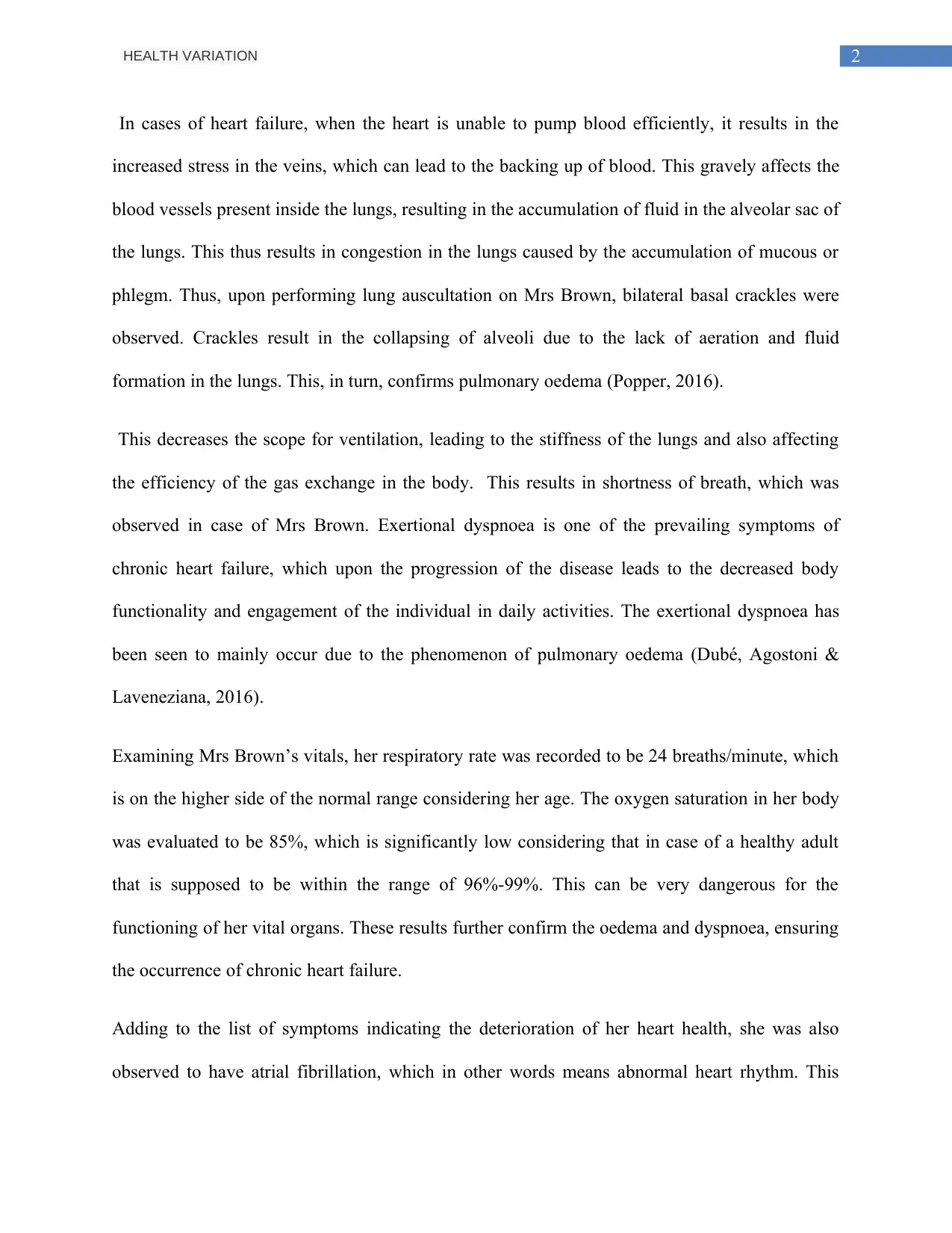
2HEALTH VARIATION
In cases of heart failure, when the heart is unable to pump blood efficiently, it results in the
increased stress in the veins, which can lead to the backing up of blood. This gravely affects the
blood vessels present inside the lungs, resulting in the accumulation of fluid in the alveolar sac of
the lungs. This thus results in congestion in the lungs caused by the accumulation of mucous or
phlegm. Thus, upon performing lung auscultation on Mrs Brown, bilateral basal crackles were
observed. Crackles result in the collapsing of alveoli due to the lack of aeration and fluid
formation in the lungs. This, in turn, confirms pulmonary oedema (Popper, 2016).
This decreases the scope for ventilation, leading to the stiffness of the lungs and also affecting
the efficiency of the gas exchange in the body. This results in shortness of breath, which was
observed in case of Mrs Brown. Exertional dyspnoea is one of the prevailing symptoms of
chronic heart failure, which upon the progression of the disease leads to the decreased body
functionality and engagement of the individual in daily activities. The exertional dyspnoea has
been seen to mainly occur due to the phenomenon of pulmonary oedema (Dubé, Agostoni &
Laveneziana, 2016).
Examining Mrs Brown’s vitals, her respiratory rate was recorded to be 24 breaths/minute, which
is on the higher side of the normal range considering her age. The oxygen saturation in her body
was evaluated to be 85%, which is significantly low considering that in case of a healthy adult
that is supposed to be within the range of 96%-99%. This can be very dangerous for the
functioning of her vital organs. These results further confirm the oedema and dyspnoea, ensuring
the occurrence of chronic heart failure.
Adding to the list of symptoms indicating the deterioration of her heart health, she was also
observed to have atrial fibrillation, which in other words means abnormal heart rhythm. This
In cases of heart failure, when the heart is unable to pump blood efficiently, it results in the
increased stress in the veins, which can lead to the backing up of blood. This gravely affects the
blood vessels present inside the lungs, resulting in the accumulation of fluid in the alveolar sac of
the lungs. This thus results in congestion in the lungs caused by the accumulation of mucous or
phlegm. Thus, upon performing lung auscultation on Mrs Brown, bilateral basal crackles were
observed. Crackles result in the collapsing of alveoli due to the lack of aeration and fluid
formation in the lungs. This, in turn, confirms pulmonary oedema (Popper, 2016).
This decreases the scope for ventilation, leading to the stiffness of the lungs and also affecting
the efficiency of the gas exchange in the body. This results in shortness of breath, which was
observed in case of Mrs Brown. Exertional dyspnoea is one of the prevailing symptoms of
chronic heart failure, which upon the progression of the disease leads to the decreased body
functionality and engagement of the individual in daily activities. The exertional dyspnoea has
been seen to mainly occur due to the phenomenon of pulmonary oedema (Dubé, Agostoni &
Laveneziana, 2016).
Examining Mrs Brown’s vitals, her respiratory rate was recorded to be 24 breaths/minute, which
is on the higher side of the normal range considering her age. The oxygen saturation in her body
was evaluated to be 85%, which is significantly low considering that in case of a healthy adult
that is supposed to be within the range of 96%-99%. This can be very dangerous for the
functioning of her vital organs. These results further confirm the oedema and dyspnoea, ensuring
the occurrence of chronic heart failure.
Adding to the list of symptoms indicating the deterioration of her heart health, she was also
observed to have atrial fibrillation, which in other words means abnormal heart rhythm. This
⊘ This is a preview!⊘
Do you want full access?
Subscribe today to unlock all pages.

Trusted by 1+ million students worldwide

3HEALTH VARIATION
causes the heart to send erratic electrical impulses, which tend to overwork the heart muscles,
leading to a weakened and ineffective heart, which loses its ability to pump blood effectively. In
cases of individuals belonging to the older age criteria, especially if they have high blood
pressure, their chances of suffering from heart attacks and eventually a heart failure increase
significantly.
Thus, the overall conditions like hypertension, tachycardia, myocardial damage, pulmonary
oedema, dyspnoea, bilateral basal crackles, and arterial fibrillation are ideal symptoms for heart-
related disorders which can eventually lead to heart failure.
Question 2
Individuals suffering from cardiac diseases, especially a heart failure, mainly face problems
regarding pain management as well as respiratory issues like shortness of breath due to
accumulation of phlegm in their lungs. Mrs Brown has been diagnosed to have suffered from an
acute exacerbation of chronic heart failure. This indicates that her condition has suddenly
worsened, due to any sort of environmental trigger, leading to shortness of breath, change in the
quantity and colour of the mucous or phlegm in the lungs.
causes the heart to send erratic electrical impulses, which tend to overwork the heart muscles,
leading to a weakened and ineffective heart, which loses its ability to pump blood effectively. In
cases of individuals belonging to the older age criteria, especially if they have high blood
pressure, their chances of suffering from heart attacks and eventually a heart failure increase
significantly.
Thus, the overall conditions like hypertension, tachycardia, myocardial damage, pulmonary
oedema, dyspnoea, bilateral basal crackles, and arterial fibrillation are ideal symptoms for heart-
related disorders which can eventually lead to heart failure.
Question 2
Individuals suffering from cardiac diseases, especially a heart failure, mainly face problems
regarding pain management as well as respiratory issues like shortness of breath due to
accumulation of phlegm in their lungs. Mrs Brown has been diagnosed to have suffered from an
acute exacerbation of chronic heart failure. This indicates that her condition has suddenly
worsened, due to any sort of environmental trigger, leading to shortness of breath, change in the
quantity and colour of the mucous or phlegm in the lungs.
Paraphrase This Document
Need a fresh take? Get an instant paraphrase of this document with our AI Paraphraser
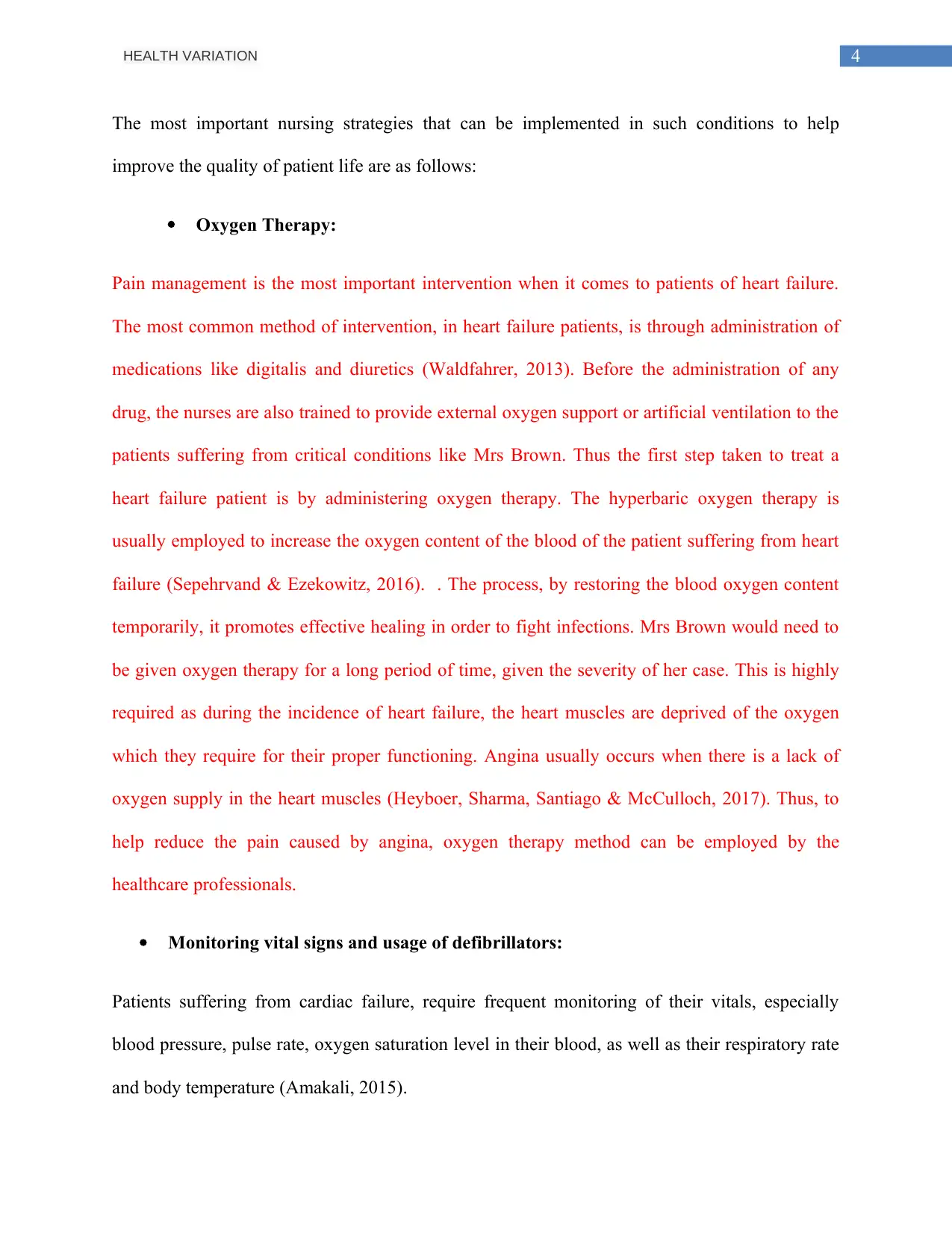
4HEALTH VARIATION
The most important nursing strategies that can be implemented in such conditions to help
improve the quality of patient life are as follows:
Oxygen Therapy:
Pain management is the most important intervention when it comes to patients of heart failure.
The most common method of intervention, in heart failure patients, is through administration of
medications like digitalis and diuretics (Waldfahrer, 2013). Before the administration of any
drug, the nurses are also trained to provide external oxygen support or artificial ventilation to the
patients suffering from critical conditions like Mrs Brown. Thus the first step taken to treat a
heart failure patient is by administering oxygen therapy. The hyperbaric oxygen therapy is
usually employed to increase the oxygen content of the blood of the patient suffering from heart
failure (Sepehrvand & Ezekowitz, 2016). . The process, by restoring the blood oxygen content
temporarily, it promotes effective healing in order to fight infections. Mrs Brown would need to
be given oxygen therapy for a long period of time, given the severity of her case. This is highly
required as during the incidence of heart failure, the heart muscles are deprived of the oxygen
which they require for their proper functioning. Angina usually occurs when there is a lack of
oxygen supply in the heart muscles (Heyboer, Sharma, Santiago & McCulloch, 2017). Thus, to
help reduce the pain caused by angina, oxygen therapy method can be employed by the
healthcare professionals.
Monitoring vital signs and usage of defibrillators:
Patients suffering from cardiac failure, require frequent monitoring of their vitals, especially
blood pressure, pulse rate, oxygen saturation level in their blood, as well as their respiratory rate
and body temperature (Amakali, 2015).
The most important nursing strategies that can be implemented in such conditions to help
improve the quality of patient life are as follows:
Oxygen Therapy:
Pain management is the most important intervention when it comes to patients of heart failure.
The most common method of intervention, in heart failure patients, is through administration of
medications like digitalis and diuretics (Waldfahrer, 2013). Before the administration of any
drug, the nurses are also trained to provide external oxygen support or artificial ventilation to the
patients suffering from critical conditions like Mrs Brown. Thus the first step taken to treat a
heart failure patient is by administering oxygen therapy. The hyperbaric oxygen therapy is
usually employed to increase the oxygen content of the blood of the patient suffering from heart
failure (Sepehrvand & Ezekowitz, 2016). . The process, by restoring the blood oxygen content
temporarily, it promotes effective healing in order to fight infections. Mrs Brown would need to
be given oxygen therapy for a long period of time, given the severity of her case. This is highly
required as during the incidence of heart failure, the heart muscles are deprived of the oxygen
which they require for their proper functioning. Angina usually occurs when there is a lack of
oxygen supply in the heart muscles (Heyboer, Sharma, Santiago & McCulloch, 2017). Thus, to
help reduce the pain caused by angina, oxygen therapy method can be employed by the
healthcare professionals.
Monitoring vital signs and usage of defibrillators:
Patients suffering from cardiac failure, require frequent monitoring of their vitals, especially
blood pressure, pulse rate, oxygen saturation level in their blood, as well as their respiratory rate
and body temperature (Amakali, 2015).
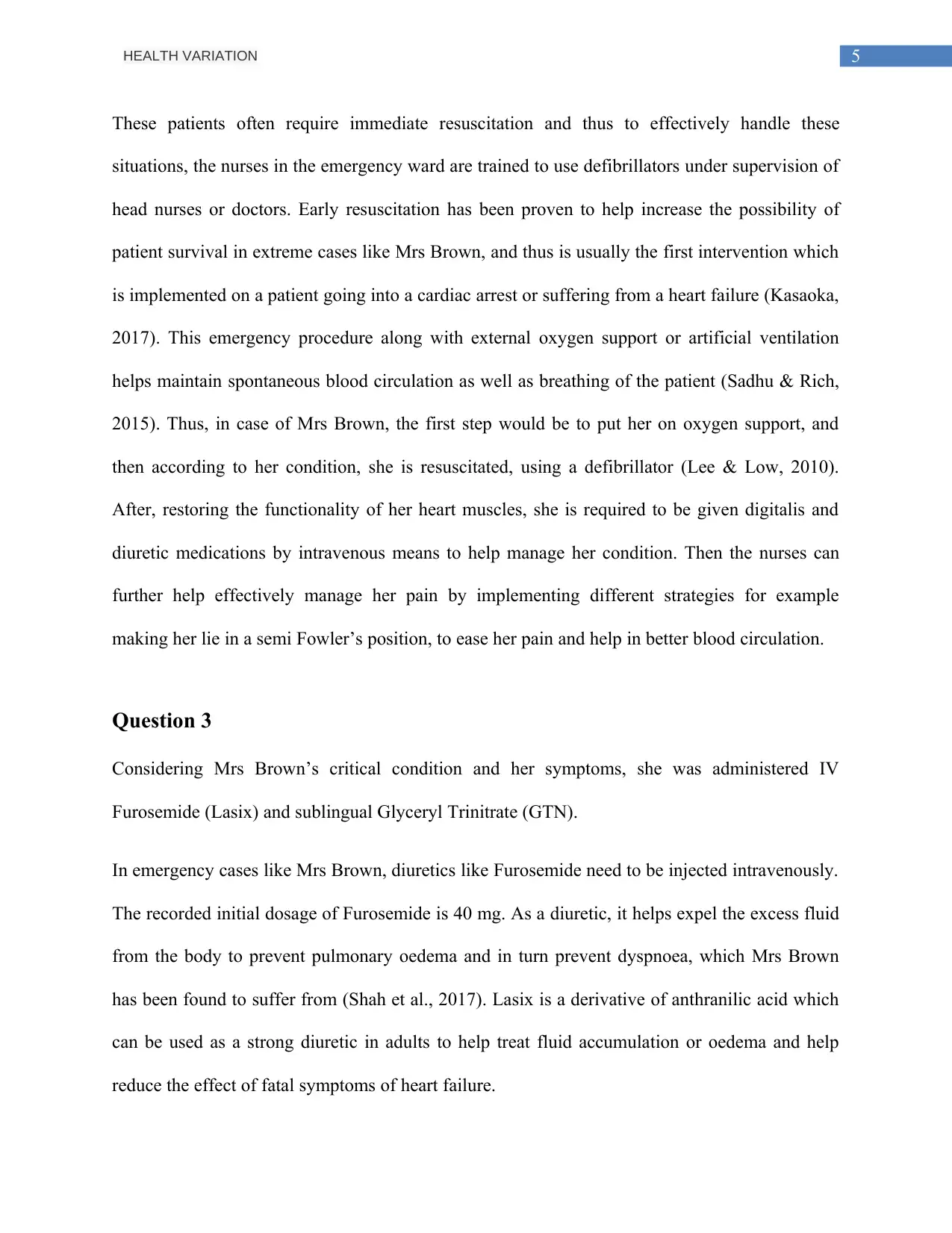
5HEALTH VARIATION
These patients often require immediate resuscitation and thus to effectively handle these
situations, the nurses in the emergency ward are trained to use defibrillators under supervision of
head nurses or doctors. Early resuscitation has been proven to help increase the possibility of
patient survival in extreme cases like Mrs Brown, and thus is usually the first intervention which
is implemented on a patient going into a cardiac arrest or suffering from a heart failure (Kasaoka,
2017). This emergency procedure along with external oxygen support or artificial ventilation
helps maintain spontaneous blood circulation as well as breathing of the patient (Sadhu & Rich,
2015). Thus, in case of Mrs Brown, the first step would be to put her on oxygen support, and
then according to her condition, she is resuscitated, using a defibrillator (Lee & Low, 2010).
After, restoring the functionality of her heart muscles, she is required to be given digitalis and
diuretic medications by intravenous means to help manage her condition. Then the nurses can
further help effectively manage her pain by implementing different strategies for example
making her lie in a semi Fowler’s position, to ease her pain and help in better blood circulation.
Question 3
Considering Mrs Brown’s critical condition and her symptoms, she was administered IV
Furosemide (Lasix) and sublingual Glyceryl Trinitrate (GTN).
In emergency cases like Mrs Brown, diuretics like Furosemide need to be injected intravenously.
The recorded initial dosage of Furosemide is 40 mg. As a diuretic, it helps expel the excess fluid
from the body to prevent pulmonary oedema and in turn prevent dyspnoea, which Mrs Brown
has been found to suffer from (Shah et al., 2017). Lasix is a derivative of anthranilic acid which
can be used as a strong diuretic in adults to help treat fluid accumulation or oedema and help
reduce the effect of fatal symptoms of heart failure.
These patients often require immediate resuscitation and thus to effectively handle these
situations, the nurses in the emergency ward are trained to use defibrillators under supervision of
head nurses or doctors. Early resuscitation has been proven to help increase the possibility of
patient survival in extreme cases like Mrs Brown, and thus is usually the first intervention which
is implemented on a patient going into a cardiac arrest or suffering from a heart failure (Kasaoka,
2017). This emergency procedure along with external oxygen support or artificial ventilation
helps maintain spontaneous blood circulation as well as breathing of the patient (Sadhu & Rich,
2015). Thus, in case of Mrs Brown, the first step would be to put her on oxygen support, and
then according to her condition, she is resuscitated, using a defibrillator (Lee & Low, 2010).
After, restoring the functionality of her heart muscles, she is required to be given digitalis and
diuretic medications by intravenous means to help manage her condition. Then the nurses can
further help effectively manage her pain by implementing different strategies for example
making her lie in a semi Fowler’s position, to ease her pain and help in better blood circulation.
Question 3
Considering Mrs Brown’s critical condition and her symptoms, she was administered IV
Furosemide (Lasix) and sublingual Glyceryl Trinitrate (GTN).
In emergency cases like Mrs Brown, diuretics like Furosemide need to be injected intravenously.
The recorded initial dosage of Furosemide is 40 mg. As a diuretic, it helps expel the excess fluid
from the body to prevent pulmonary oedema and in turn prevent dyspnoea, which Mrs Brown
has been found to suffer from (Shah et al., 2017). Lasix is a derivative of anthranilic acid which
can be used as a strong diuretic in adults to help treat fluid accumulation or oedema and help
reduce the effect of fatal symptoms of heart failure.
⊘ This is a preview!⊘
Do you want full access?
Subscribe today to unlock all pages.

Trusted by 1+ million students worldwide

6HEALTH VARIATION
Sublingual Glyceryl Trinitrate (GTN) refers to tablets which can be administered to the patients
suffering from cardiac failure, by putting them under their tongue in order for them to provide
instantaneous relief from angina (Sidhu, Boden, Padala, Cabral & Buschmann, 2015). The
tablets are administered under the tongue, as this region of the mouth consists of a huge supply
of blood vessels, which helps the medicine get absorbed easily and quickly. The acute effects of
the medication can be mainly described as the reduction of the systolic blood pressure, which is
ideal for Mrs Brown, given she suffered from a systolic dysfunction leading to a chronic heart
failure.
Sublingual Glyceryl Trinitrate (GTN) refers to tablets which can be administered to the patients
suffering from cardiac failure, by putting them under their tongue in order for them to provide
instantaneous relief from angina (Sidhu, Boden, Padala, Cabral & Buschmann, 2015). The
tablets are administered under the tongue, as this region of the mouth consists of a huge supply
of blood vessels, which helps the medicine get absorbed easily and quickly. The acute effects of
the medication can be mainly described as the reduction of the systolic blood pressure, which is
ideal for Mrs Brown, given she suffered from a systolic dysfunction leading to a chronic heart
failure.
Paraphrase This Document
Need a fresh take? Get an instant paraphrase of this document with our AI Paraphraser
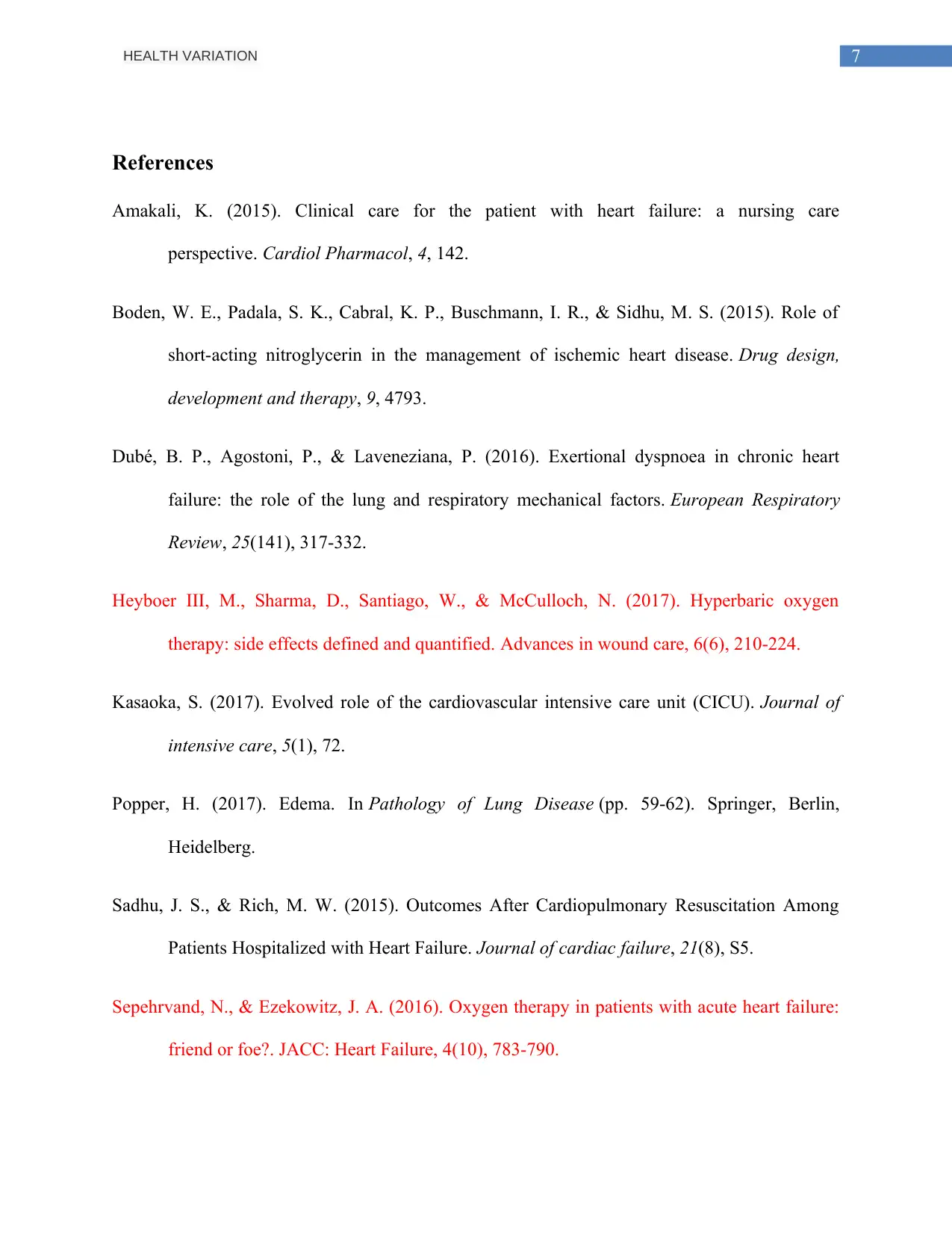
7HEALTH VARIATION
References
Amakali, K. (2015). Clinical care for the patient with heart failure: a nursing care
perspective. Cardiol Pharmacol, 4, 142.
Boden, W. E., Padala, S. K., Cabral, K. P., Buschmann, I. R., & Sidhu, M. S. (2015). Role of
short-acting nitroglycerin in the management of ischemic heart disease. Drug design,
development and therapy, 9, 4793.
Dubé, B. P., Agostoni, P., & Laveneziana, P. (2016). Exertional dyspnoea in chronic heart
failure: the role of the lung and respiratory mechanical factors. European Respiratory
Review, 25(141), 317-332.
Heyboer III, M., Sharma, D., Santiago, W., & McCulloch, N. (2017). Hyperbaric oxygen
therapy: side effects defined and quantified. Advances in wound care, 6(6), 210-224.
Kasaoka, S. (2017). Evolved role of the cardiovascular intensive care unit (CICU). Journal of
intensive care, 5(1), 72.
Popper, H. (2017). Edema. In Pathology of Lung Disease (pp. 59-62). Springer, Berlin,
Heidelberg.
Sadhu, J. S., & Rich, M. W. (2015). Outcomes After Cardiopulmonary Resuscitation Among
Patients Hospitalized with Heart Failure. Journal of cardiac failure, 21(8), S5.
Sepehrvand, N., & Ezekowitz, J. A. (2016). Oxygen therapy in patients with acute heart failure:
friend or foe?. JACC: Heart Failure, 4(10), 783-790.
References
Amakali, K. (2015). Clinical care for the patient with heart failure: a nursing care
perspective. Cardiol Pharmacol, 4, 142.
Boden, W. E., Padala, S. K., Cabral, K. P., Buschmann, I. R., & Sidhu, M. S. (2015). Role of
short-acting nitroglycerin in the management of ischemic heart disease. Drug design,
development and therapy, 9, 4793.
Dubé, B. P., Agostoni, P., & Laveneziana, P. (2016). Exertional dyspnoea in chronic heart
failure: the role of the lung and respiratory mechanical factors. European Respiratory
Review, 25(141), 317-332.
Heyboer III, M., Sharma, D., Santiago, W., & McCulloch, N. (2017). Hyperbaric oxygen
therapy: side effects defined and quantified. Advances in wound care, 6(6), 210-224.
Kasaoka, S. (2017). Evolved role of the cardiovascular intensive care unit (CICU). Journal of
intensive care, 5(1), 72.
Popper, H. (2017). Edema. In Pathology of Lung Disease (pp. 59-62). Springer, Berlin,
Heidelberg.
Sadhu, J. S., & Rich, M. W. (2015). Outcomes After Cardiopulmonary Resuscitation Among
Patients Hospitalized with Heart Failure. Journal of cardiac failure, 21(8), S5.
Sepehrvand, N., & Ezekowitz, J. A. (2016). Oxygen therapy in patients with acute heart failure:
friend or foe?. JACC: Heart Failure, 4(10), 783-790.

8HEALTH VARIATION
Shah, N., Madanieh, R., Alkan, M., Dogar, M. U., Kosmas, C. E., & Vittorio, T. J. (2017). A
perspective on diuretic resistance in chronic congestive heart failure. Therapeutic
advances in cardiovascular disease, 11(10), 271-278.
Waldfahrer, F. (2013). Management of patients with risk factors. GMS current topics in
otorhinolaryngology, head and neck surgery, 12.
Shah, N., Madanieh, R., Alkan, M., Dogar, M. U., Kosmas, C. E., & Vittorio, T. J. (2017). A
perspective on diuretic resistance in chronic congestive heart failure. Therapeutic
advances in cardiovascular disease, 11(10), 271-278.
Waldfahrer, F. (2013). Management of patients with risk factors. GMS current topics in
otorhinolaryngology, head and neck surgery, 12.
⊘ This is a preview!⊘
Do you want full access?
Subscribe today to unlock all pages.

Trusted by 1+ million students worldwide
1 out of 9
Related Documents
Your All-in-One AI-Powered Toolkit for Academic Success.
+13062052269
info@desklib.com
Available 24*7 on WhatsApp / Email
![[object Object]](/_next/static/media/star-bottom.7253800d.svg)
Unlock your academic potential
Copyright © 2020–2025 A2Z Services. All Rights Reserved. Developed and managed by ZUCOL.





